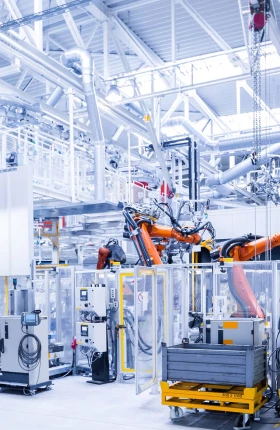Many manufacturing companies have enthusiastically embarked on predictive maintenance journeys, only to discover that the road is fraught with data obstacles, change management hurdles, and business model challenges that undermine their well-intended initiatives. Despite the appeal of using AI to predict the condition of enterprise assets and machinery, the reality is that the implementation and monetization process can be a humbling experience.
The challenges of predictive maintenance are not rooted in the technology itself, but rather stem from two interconnected issues.
First, many companies struggle with the data infrastructure. This starts with a lack of accurate failure data. These records are essential for developing advanced algorithms and training predictive models because they show when a machine failed and why. Too often this data is manually recorded, incomplete, inaccurate, or—even worse—nonexistent. Without this data, training a model to anticipate machinery failure becomes a Herculean task. Challenges in leveraging predictive maintenance efforts extend far beyond gathering the right data to putting the data to use effectively. Many organizations struggle with interpreting complex machinery data and subsequently fail to leverage it effectively for predictive maintenance efforts. Additionally, the quality of sensor data is poor. It is often incomplete, inconsistent, and unstandardized. Malfunctioning sensors can further muddle the data landscape by reducing the overall reliability of the data and making it difficult for manufacturers to derive meaningful insights.
Many organizations struggle with interpreting complex machinery data and subsequently fail to leverage it effectively for predictive maintenance efforts.
Second, most organizations fail to operationalize predictive maintenance on the shop floor, on the road, or in the field—missing opportunities to improve workforce or customer productivity. They don’t involve users enough in the upfront design of the solution and then underinvest in change management upon implementation. Even companies that have successfully implemented predictive maintenance often struggle either to realize cost reductions internally or to monetize with customers externally, through subscription services, to meet the original business case.
The road to predictive maintenance is not a straight one for many companies, and BCG X has worked with numerous global manufacturing companies to address these challenges. Our approach to predictive maintenance has been distilled into our comprehensive software suite: MFG AI . This offering encompasses five strategies that have empowered our clients to surmount these data hurdles, allowing them to overcome data obstacles and chart a path toward predictive maintenance success.
Leveraging Human Expertise to Fill Data Gaps
Our first strategy involves harnessing the vast human expertise in this field. During a project with a major food-processing machine manufacturer, we grappled with high-priority use cases where data was minimal. To address these data gaps, we collaborated with experts such as R&D specialists, controls engineers, and service technicians who had years of hands-on experience and—if given the right data—could diagnose and anticipate problems with the machines.
By working closely with these experts, we identified key data points, developed pattern-matching algorithms to detect abnormalities, and continually reviewed and refined the algorithms on the basis of expert feedback. The insights from this team of experienced human professionals enabled us to bridge data gaps and create a machine-learning model that is essentially a virtual expert—one that can monitor a machine 24-7, predict when a failure will happen, and recommend insights and corrective actions to the maintenance team.
Using Generative Data Augmentation to Overcome Data Scarcity
The second strategy involves tackling data scarcity with generative adversarial networks (GANs). These advanced tools use a data augmentation technique to generate synthetic data, which mimics the properties of existing data and exponentially enhances the data set for model training.
Generative data augmentation techniques allow companies to tackle data scarcity issues head-on, as manufacturers are not restricted to developing models only where they have ample amounts of existing, high-quality data.
We successfully put this strategy to work to develop a computer vision–based grading application for a large processed-food manufacturer. Tasked with detecting seldom-documented rare defects, our team used GANs to generate synthetic images of these defects. This synthetic data allowed us to train the algorithm effectively, thus accurately identifying the rare defects despite the limited original data. By creating diversity in the data set, this AI-enabled form of augmentation empowered our predictive maintenance models to better understand various maintenance scenarios, enhancing prediction accuracy and reliability.
Crowdsourcing Algorithms to Iterate Quickly
Our third strategy is rooted in the wisdom of crowds and the power of simplicity. While working on a predictive maintenance implementation for a major construction equipment manufacturer, we opted to start by crowdsourcing many simple algorithms rather than building one complex model to predict machine failures. Developing a single advanced model would have required significant time and provided no safeguards or backup. By crowdsourcing a number of algorithms, we were able to spin up multiple models, each with different logic, which provided safeguards and allowed us to determine the right algorithm by having them vote against one another.
This approach was not only cost-effective but also allowed us to experiment quickly and fail safely.
In addition to pursuing this crowdsourcing approach, we worked closely with the operations staff to incorporate their experience and insights in refining the algorithms and improving their effectiveness. This collaboration ensured that our models were rooted in the reality of the shop floor, not just theoretical assumptions.
Improving Operations and Workforce Productivity with Generative AI
Working with a revered, century-old original equipment manufacturer (OEM), we discovered an opportunity to enhance the effectiveness of predictive maintenance using generative AI. Our goal was to amplify impact by linking predictive maintenance algorithms with our team’s GenAI-powered maintenance copilot, a proof-of-concept tool that helps bridge gaps in the maintenance cycle.
When the copilot receives a maintenance alert from the predictive maintenance models, it quickly generates a custom repair plan with detailed instructions tailored to the OEM’s specific machinery issues. This approach not only swiftly identifies the problem and its solution by determining the necessary parts, checking their availability, and estimating costs, but also sends this critical information to the technician. In addition, the copilot prepares necessary documents for upcoming maintenance, with the goal of synchronizing repair tasks with planned downtimes, thereby transforming a days-long process into mere moments.
Here, the combined power of predictive maintenance and GenAI not only enhances the OEM’s operations—it transforms them. Streamlining this process also significantly increases workforce productivity by enabling maintenance staff to focus on executing well-planned repair strategies rather than spending time on identifying problems.
Investing in Change Management and Smart Monetization Strategies
Once we have solved the data challenges and built a successful predictive maintenance algorithm and solution, the real work begins. With successful predictive maintenance programs, many companies find that internal monetization is easier to attain, as reductions in warranty costs, decreased rework, and minimized downtime all translate into quick gains including throughput and yield increases. But this still requires a solution that fits into the existing workflow of the users. Companies that involve their end users upfront in the design often see the best results. And once deployed, a thoughtful and hands-on change management program involving “super users” is critical to ensure adoption and integration of the solution into day-to-day activities.
With successful predictive maintenance programs, many companies find that internal monetization is easier to attain than external monetization.
When it comes to external monetization—particularly with OEMs—there is often a struggle to make a compelling business case owing to the challenges of transferring costs to customers through higher upfront prices or incremental subscription plans. To address this issue, OEMs can consider shifting toward offering life cycle service packages that provide customers with a fixed price for aftermarket support, converting variable aftermarket costs and downtime risk into a stable, predetermined payment with better uptime and lower risk. For example, we effectively used this strategy when working with a leading equipment manufacturer by developing and scaling a digital aftermarket business model. We created different service packages tailored to the OEM customers’ needs, including reduced costs during the time of purchase, synchronized timing of expenses with benefits, as well as prompt and accurate over-the-air updates of software and analytical models.
This smart approach to monetization not only ensured a recurring revenue stream for the OEM but also provided significant benefits for its customers—a true win-win.
Moving Forward
By adopting these five strategies, BCG X has helped manufacturing companies overcome common issues related to data scarcity and quality, implement successful predictive maintenance programs leveraging the latest advances in AI, and commercialize and monetize this capability. After companies have scaled with predictive maintenance, we have seen them reduce unplanned downtime by 20% to 40% and decrease the total cost of ownership by 10%.
At BCG X, we tailor solutions to manufacturing clients’ needs using the MFG AI platform, which provides a robust platform, versatile data model, and unique AI methodology to address maintenance challenges. In addition to matching companies with the right technology and algorithmic solutions, we also recognize that change management and team enablement are critical activities for capturing value and ensuring sustained success.
The journey to comprehensive AI adoption in manufacturing is not without challenges. But we believe that any organization can make significant strides toward this goal. This involves focusing on human expertise, leveraging advanced data augmentation techniques and GenAI, balancing cutting-edge models with the power of simplicity, and realizing that success goes beyond the technical solution build and includes thoughtful user-centric design, rigorous change management, and smart monetization strategies.
We’ve done it, and we’re ready to help others navigate this journey.
The authors thank their BCG colleagues Joakim Kalvenes and Liam Murphy.

















